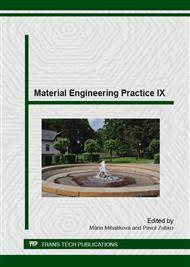p.122
p.127
p.131
p.135
p.139
p.143
p.147
p.151
p.157
A Comparison of Mechanical Properties of Lumbar Bilateral Implants Manufactured by Additive and Conventional Technologies
Abstract:
Spinal implants are mechanical equipments that facilitate fusion, correct deformities, and stabilize and strengthen the spine. To make an implant efficient, it has to endure without any failure, especially mechanical damage, stand all the static and dynamic loads incurred in spine during everyday activities, and maintain the necessary position of motive segments during the bone adhesion. [1] Human spine is exposed to the highest load in the lumbar section [2]; therefore, lumbar bilateral implants require higher attention in terms of mechanical parameters verification. The main objective of this paper was to compare mechanical properties of lumbar bilateral systems using the spinal implants manufactured by the conventional method and the Direct Metal Laser Sintering method (DMLS). Detection of mechanical properties enables the assessment of possible replacement of commercial manufacture with the DMLS manufacture. On the basis of the ASTM F1717 standards providing the essentials for the comparison of mechanical properties of spinal systems, twenty mechanical compression tests were carried out. Mechanical tests were carried out using 20 spinal bars with the diameter of 11 mm and the fastening length of 260 mm, manufactured by the DMLS technology while using the EOSINT M280 equipment (EOS, Germany), and 20 identical spinal bars manufactured by the conventional technology. Results obtained in mechanical compression tests indicate that both manufacture methods are comparable and there are no significant differences between them, as for the strength characteristics. Other trials will be focused on static tensile tests and cyclical tests of lumbar bilateral systems.
Info:
Periodical:
Pages:
139-142
Citation:
Online since:
December 2014
Authors:
Price:
Сopyright:
© 2015 Trans Tech Publications Ltd. All Rights Reserved
Share:
Citation:


